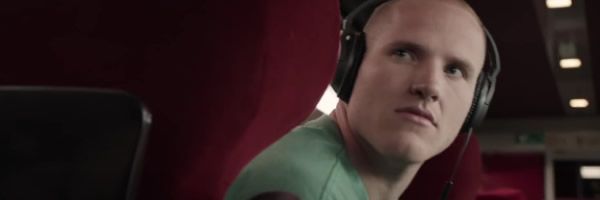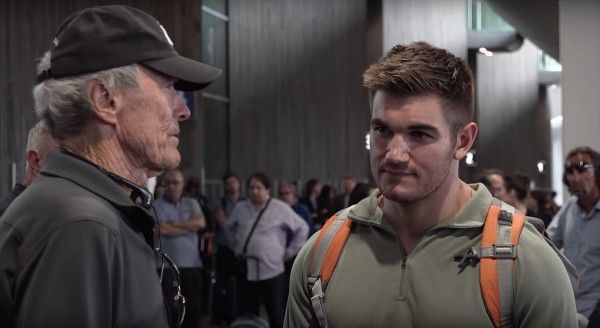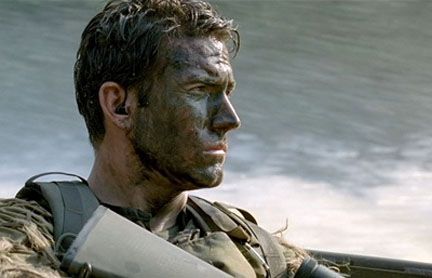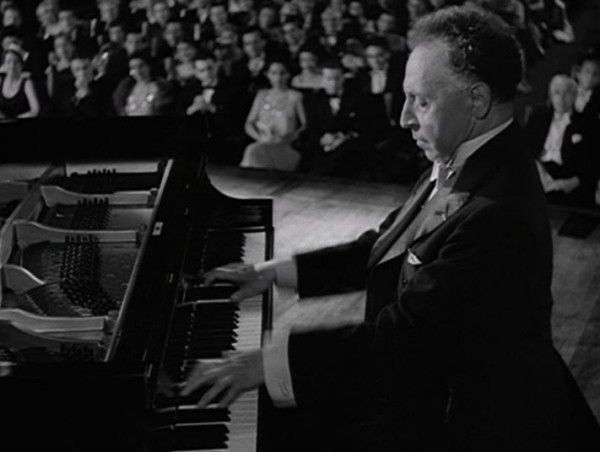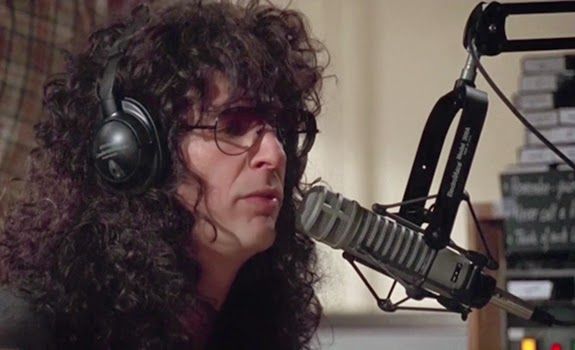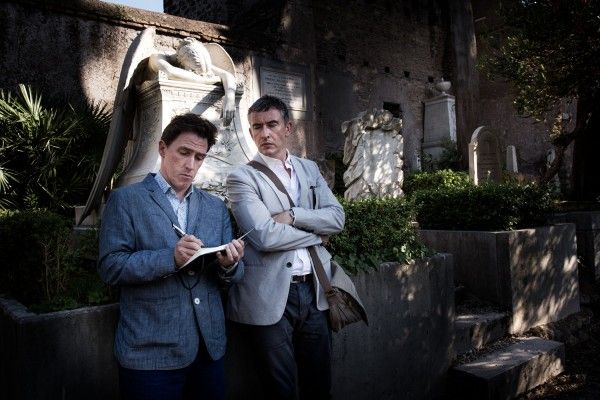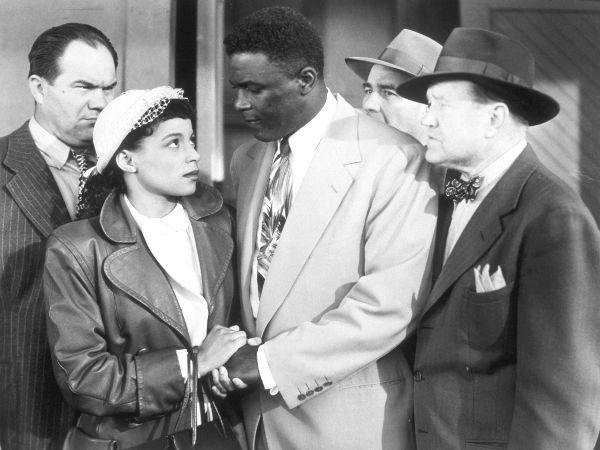If one were to watch the trailer for Clint Eastwood’s The 15:17 to Paris scrubbed of any information about the casting, it’d be understandable to assume that the movie relies on a certain amount of American propaganda. The movie, centered around the 2015 terrorist attack on a train heading from Amsterdam to Paris, follows the three American men – an SSU student, an Oregon National Guard serviceman, and a staff sergeant in the Air Force – who foiled the ISIS attack that might have cost the lives of 500 citizens. Neither Eastwood nor Dorothy Byskal’s script suggests serious interest in how the other side lives or, for that matter, how American foreign policy essentially created ISIS. The interest would seemingly be on the purity of American heroism, but anyone who takes this assumption seriously clearly hasn’t paid close attention to Eastwood’s past movies. For all the perceived xenophobia in his films, most memorably in American Sniper, the director's focus has always been on the devastating toll of violence and repression on the American character.
The crux of The 15:17 to Paris is in its casting of the three real-life heroes – Anthony Sadler, Alek Skarlatos, and Spencer Stone – as themselves in the film, allowing for a narrative adaptation of a terrifying event to be cut with a kind of observational documentary. Though the events are no doubt heroic, what Eastwood has decided to hook onto is the experience of these men reliving the act as performance, surrounded by well-know actors and actresses like Judy Greer, Jenna Fischer, and Urkel himself, Jaleel White. The use of performers that are most familiar from TV – Reno 911’s Thomas Lennon and Veep’s Tony Hale also appear – not only alludes to the breadth between real life as compared to what's seen on TV and the fickleness of memory but also the feeling of alienation from friends, family, and others after such a traumatic event.
Eastwood isn’t the first one to dream up the idea of casting honest-to-goodness soldiers as themselves in action films or dramas. Plenty of movies have utilized actual soldiers, cops, firefighters, and intelligence agency veterans in supporting parts – Mickey O’Keefe’s performance in The Fighter comes to mind – but only a handful have featured them in the lead. Most memorable is First Lieutenant Audie March’s performance in 1955’s To Hell and Back, which purports to trace March’s life from a hard-working farm boy to one of the most decorated and celebrated veterans of World War II. At the time, March’s lead was seen as spectacle rather than experiment, a way of rousing a tinny sense of patriotism and trust in the armed forces rather than to reflect on March’s intimate experiences and wisdom gleaned from his life. Indeed, as directed by Jesse Hibbs, the movie feels plain and weightless, especially when compared to the innumerable great World War II movies of the era, from Attack and The Bridge on the River Kwai to The Desert Rats and Stalag 17.
The problem with To Hell and Back is that March doesn’t really stand out, even in a movie about his days in the infantry. Perhaps it was meant to underline the idea that no one is special in the army, but it doesn’t come off that way. Similarly, Act of Valor, the 2012 action film starring active duty Navy SEALs and crewman, unconvincingly details the lives of the SEALs as centered exclusively around family, faith, and the military. One of them plays the guitar and there are allusions to hobbies but there’s never any sense that the dedication, passion, or technical efficiency and skill they show as soldiers carries over to anything else other than their wives and kids. The performers, led by Rorke Denver, are utilized only for their physicality and their familiarity with how high-level military operations are carried out. Dramatically, neither Denver nor any of the SEALs are particularly engaging or convincing, and their communications when on the job are limited mostly to gestures. Their appearance in what is otherwise a familiar scenario of good Americans bravely fighting off bad terrorists and drug smugglers – they are essentially conflated – comes off as solely for publicity. They are no more revealing or involving than a pack of well-trained stunt men in the realm of Mike McCoy and Scott Waugh’s movie.
The scrubbing of any inner life or existence outside of the home and job from these soldiers also allows for the filmmakers to easily sanctify them and, by extension, harp on the very real tragedy of soldiers being killed in action to the point of borderline exploitation. The fact that the movie buys into such basic, anti-intellectual action-film stereotypes, including a master terrorist who enjoys classical music and a drug smuggler who likes to read big books, renders what might have been a crucial window into the life of real soldiers into a very loud Navy advertisement made up primarily of Call of Duty cut scenes.
In the right hands, extensive training and honed physical talents can prove exhilarating. In Carnegie Hall, Edgar G. Ulmer’s riveting musical melodrama from 1947, the director expanded an original concept to simply film a number of classical piano, symphony, and vocal performances in the titular New York venue to include a rousing tale of a widow’s (Marsha Hunt) overbearing plan for her piano prodigy son (William Prince). Rather than depend on dubbing or cutting around an actor and the hands of a musician to create the illusion of virtuosity, Ulmer dedicates much of the runtime to mesmerizing sequences of Lily Pons, Gregor Piatigorsky, Risë Stevens, Artur Rodzinski, and Artur Rubinstein singing or playing their hearts out. Working with DP William Miller and editor Fred R. Feitshans Jr., Ulmer creates rhythmic, entrancing scenes of little more than Rubinstein rapturously banging away at his keys or Bruno Walter conducting a symphony with vigor and extraordinary concentration. In Ulmer’s vision, the spirit of the music can only be fully communicated on film by showing how cinematic a masterful musician can be on their own when there’s no one worrying about having a familiar, classically attractive face pressed against a violin or pretending to belt one out.
Both Shirley Clarke’s The Connection and Bertrand Tavernier’s ‘Round Midnight make even more radical use of jazz musicians, namely Jackie McLean and Dexter Gordon, respectively. The former depicts a gang of heroin junkies, including McLean, who was himself an addict at the time, waiting around for the dealer to arrive, musing about a life of addiction and launching into improvisational jazz sessions along the way. The twist is that Clarke’s film is a kind of documentary, as both the man holding the camera and his director are characters as well, played by Roscoe Lee Browne and William Redfield. Clarke devotes a sizable portion of her runtime to Maclean playing with Freddie Redd, drummer Larry Richie, and bass player Michael Mottis while waiting for their dope. As a director, she ultimately implicates herself as an addict as well, always searching for the next glimpse of truth or beauty through her camera. ‘Round Midnight comparatively utilizes Gordon’s talents as a musician for lively sequences of sets at small-time gigs. Though he’s given a fictional character to play, which boils down to a slightly augmented version of himself, the brilliant saxophonist gave one of the best performances of 1986 in Tavernier’s film.
Judd Apatow has shown an unshakeable talent for getting extraordinary performances out of recognizable artists and celebrities in cameo roles, such as Eminem’s eruption at Ray Romano gawking at him in Funny People or Ryan Seacrest’s tirade against fame in Knocked Up. (Eminem, also known as Marshall Mathers, also turned in a stirring, long-form performance as himself in Curtis Hanson's 8 Mile.) Aside from his uproarious take on Factory Records founder Tony Wilson in 24 Hour Party People, Steve Coogan’s best performances have been as versions of himself, such as in Michael Winterbottom's Trip movies and Tristram Shandy: A Cock and Bull Story. There’s also a special place in my heart for Howard Stern’s wildly fascinating take on his own rise to stardom in Private Parts. He can often come off as pompous and brazenly politically incorrect, but in recreating the comedic freedom he engendered in the booth with his team, director Betty Thomas makes a funny and convincing case for liberated talk and ideas on the radio and in other arts, no matter how stupid or arguably offensive the material may be. And for what it’s worth, Stern shows immense promise as a physical performer in these scenes, expressing boundless comedic energy funneled through a distinct perspective and a lanky body. If Stern were born a few decades earlier, he ironically might have made a great silent comedian.
For whatever unexpected delights might have come from those performances, the most resonant instance of this kind of casting came in 1950, when Jackie Robinson played himself in Alfred E. Green’s The Jackie Robinson Story. Though consistently engaging in his dramatic scenes with the likes of Ruby Dee’s Rae Robinson and Minor Watson’s Branch Rickey, Robinson is spellbinding in his quieter moments, which are tied to Green’s unflinching vision of systemic racism in baseball. Rickey warns Robinson at one point that he can’t do anything when faced with racists both inside the Brooklyn Baseball Club and out, and it's in his inability to speak in his defense that the movie is most vital and heartbreaking. It’s reflective of experiences that don’t speak well of America’s attitude towards race and yet speaks directly to what people love about baseball, itself an inherent symbol of Americana.
There’s no reason that the military shouldn’t be held to the same standards if it’s going to so clearly be one of our most prominent symbols overseas. Hopefully Eastwood’s movie is only the first step in the right direction of allowing our soldiers and veterans to help tell their own complex stories, rather than simply paint them as iconic heroes meant to be celebrated without question or criticism.

